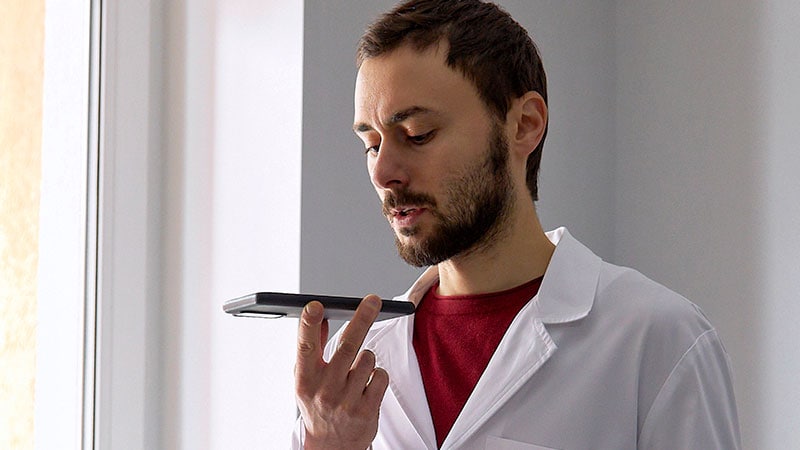MADRID — An artificial intelligence (AI)-driven voice algorithm showed “excellent agreement” with the American Diabetes Association (ADA) risk test in detecting adults with type 2 diabetes (T2D), research presented at the European Association for the Study of Diabetes (EASD) 2024 Annual Meeting revealed.
The AI model detected T2D with 66% accuracy among women and 71% in men, and there was 93% agreement with the questionnaire-based ADA risk score, demonstrating comparable performance between voice analysis and an accepted screening tool.
The Colive Voice project includes volunteers from all over the world; however, the current study was restricted to adults from the United States, both with and without T2D, Guy Fagherazzi, PhD, director of the Department of Precision Health at the Luxembourg Institute of Health, Strassen, Luxembourg, told Medscape Medical News.
“This first proof of concept was limited to English speakers, and further research will need to enroll more diverse populations, in terms of languages and sociodemographic background,” he said.
The researchers developed the model based on an average of 25 seconds of participants’ voices — from a voice recording of a few sentences on their smartphone or laptop — and relevant health data, including age, sex, body mass index (BMI), and blood pressure. Algorithms were trained and cross-validated for men and women separately and evaluated for accuracy, specificity, sensitivity, and area under the curve (AUC).
In total, the team analyzed input from 323 women (162 with T2D, 161 without) and 284 men (142 with T2D, 142 without). Participants with T2D were older and more frequently living with obesity. Specifically, women with T2D had an average age of 49.5 years vs 40.0 years for women without T2D, and men with T2D averaged 47.6 years vs 41.6 years.
Women with T2D had an average BMI of 35.8 vs 28.0 for those without T2D, and men with T2D had an average BMI of 32.8 vs 26.6 for those without.
The AI algorithm analyzed various vocal features, such as changes in pitch, intensity, and tone, from a total of 607 recordings to identify differences between individuals with and without diabetes. This was done using two techniques: One that captured up to 6000 detailed vocal characteristics, and a deep learning approach that focused on a refined set of 1024 key features.
The voice-based algorithm achieved good overall predictive capacity (AUC = 75% for men, 71% for women) and correctly predicted 71% of male and 66% of female T2D cases. The model performed even better in women aged 60 years and older (AUC = 74%) and also in those with hypertension for both men and women (AUC = 75%).
“This study represents a first step toward using voice analysis as a first-line, highly scalable T2D screening strategy,” the authors concluded.
“The next studies will have to demonstrate the robustness of our approach in diverse populations and also include people living with prediabetes,” Fagherazzi said. “If proven reliable, we expect such technology to be available in the next 5-10 years. Then, it could be deployed easily at scale in millions of smartphones worldwide and reduce undiagnosed diabetes cases.”
Gianluca Iacobellis, MD, PhD, director of the University of Miami Hospital Diabetes Service, Coral Gables, Florida, commented on the study for Medscape Medical News. There are only a few very recent studies that suggest that blood glucose levels can affect voice characteristics, he said.
The reasoning behind this is “due to Hooke’s law, in which changes in the tension, mass, or length of the vocal folds,” mediated by different glucose levels, “may result in an alteration in their vibrational frequency,” he explained. “Whether or not voice assessment can help in detecting people with diabetes is unknown, and we need much more robust evidence,” he said. “Many parameters such as age, smoking, gender, body phenotype, and emotional and psychological factors can confound and affect the voice.”
The study didn’t define the criteria used to diagnose diabetes vs no diabetes, he noted. Furthermore, “voice should be recorded for 24 hours of a routine day and correlated with continuous glucose monitoring data of that day.”
Of note, another recent study published in Scientific Reports investigated the connection between blood glucose levels and voice frequency across three glycemic statuses — nondiabetic, prediabetic, and type 2 diabetic. Participants wore continuous glucose monitors (CGMs) and recorded their voices multiple times daily for 2 weeks. The analysis revealed a linear relationship showing that an increase in CGM glucose levels corresponded to an increase in the fundamental frequency of the voice, laying the groundwork for more research using voice to predict and monitor glucose levels.
No information regarding funding was provided. Fagherazzi and Iacobellis reported no conflicts of interest.



